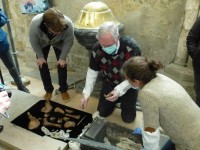 Last year, a team of French, Danish and Norwegian researchers exhumed skeletal remains from the tombs of two medieval dukes of Normandy, direct descendants of Rollo, the 10th century Viking raider who so effectively plundered the towns along the Seine that King Charles the Simple had to bribe him with great swaths of property. Those lands would become the Duchy of Normandy, and one of those dukes, Rollo’s three times great-grandson William the Bastard, would conquer England.
Last year, a team of French, Danish and Norwegian researchers exhumed skeletal remains from the tombs of two medieval dukes of Normandy, direct descendants of Rollo, the 10th century Viking raider who so effectively plundered the towns along the Seine that King Charles the Simple had to bribe him with great swaths of property. Those lands would become the Duchy of Normandy, and one of those dukes, Rollo’s three times great-grandson William the Bastard, would conquer England.
The lead ossuaries buried in the graves of Rollo’s grandson Richard I (known as Richard the Fearless) and his great-grandson Richard II (Richard the Good) were raised from under the floor of Fécamp Abbey on February 29th, 2016. The researchers’ aim was to recover teeth that might contain extractable DNA. The DNA might then answer a question that has long bedeviled historians: was Rollo Norwegian or Danish? Medieval chronicles and sagas differ on the subject. Per Holck, Professor Emeritus at the University of Oslo, and University of Copenhagen geneticist Andaine Seguin Orlando got permission from the French government to open the ossuaries in the hope genetic testing might resolve the debate over Rollo’s origins once and for all.
 They were lucky at first. One of the ossuaries, the one purportedly containing the remains of Duke Richard II, included a lower mandible with eight teeth. Because recovering nuclear DNA from ancient remains is always difficult, often impossible, due to degradation of organic remains and environmental contaminants, teeth provide the best opportunity to retrieve viable, clean DNA because the genetic material is in the pulp, encased in and protected by layers of dentin and enamel. The team was allowed to keep five of the teeth which they sent to the University of Oslo and the University of Copenhagen’s Centre for GeoGenetics for testing.
They were lucky at first. One of the ossuaries, the one purportedly containing the remains of Duke Richard II, included a lower mandible with eight teeth. Because recovering nuclear DNA from ancient remains is always difficult, often impossible, due to degradation of organic remains and environmental contaminants, teeth provide the best opportunity to retrieve viable, clean DNA because the genetic material is in the pulp, encased in and protected by layers of dentin and enamel. The team was allowed to keep five of the teeth which they sent to the University of Oslo and the University of Copenhagen’s Centre for GeoGenetics for testing.
That’s where their good luck ended. They were unable to extract any DNA from the teeth, which were too old, had been exposed to high moisture levels and contaminated by decades spent in a lead ossuary. After hitting the wall on genetic analysis, researchers decided they might as well date the bones. When the radiocarbon dating results came in they blew apart any chance of the remains providing new information about Rollo. The bones in the ossuaries do not belong to Richard I and Richard II of Normandy. They long predate the Richards. In fact, they long predate Rollo himself. One of them dates to 704 (+/- 28 years), the Merovingian era, so more than 200 years before Rollo started marauding on the Seine. The bones belonged to a man, tall for his time at 1.8 meters (5’11”), and because his right forearm is slightly longer than his left, he was likely a warrior. The other is even older than that, like a thousand years older. It dates to 286 B.C. (+/- 27 years), which means it not only predates the Viking era, it predates the Roman occupation of the area.
 It’s not a huge shock that the ossuaries did not contain the remains of Richard I and II. As I noted in last year’s article about the exhumation, the remains were repeatedly moved over the centuries. The Dukes were buried outside the Church of the Holy Trinity in Fécamp, consecrated in 990. They both requested that they be buried under a water channel so their sins could be washed away for eternity. Their remains were moved and buried inside the new Romanesque church in 1162 by order of Henry II of England, Duke Richard II’s three times great-grandson. They were moved again in 1518 to the high altar of the Gothic church, and again in 1748. The remains were rediscovered in 1942 when work was done on the church, and the bones were reburied in 1947. They were moved one last time in 1956 when they were placed in those lead boxes and moved to the southern transept where researchers at the time believed was the closest spot to the original burial location.
It’s not a huge shock that the ossuaries did not contain the remains of Richard I and II. As I noted in last year’s article about the exhumation, the remains were repeatedly moved over the centuries. The Dukes were buried outside the Church of the Holy Trinity in Fécamp, consecrated in 990. They both requested that they be buried under a water channel so their sins could be washed away for eternity. Their remains were moved and buried inside the new Romanesque church in 1162 by order of Henry II of England, Duke Richard II’s three times great-grandson. They were moved again in 1518 to the high altar of the Gothic church, and again in 1748. The remains were rediscovered in 1942 when work was done on the church, and the bones were reburied in 1947. They were moved one last time in 1956 when they were placed in those lead boxes and moved to the southern transept where researchers at the time believed was the closest spot to the original burial location.
 Somewhere in the middle of all that, the bones of a man from the 8th century and one from the 3rd century B.C. were confused for those of two dukes of Normandy. So the Rollo thing is a total bust, but now there’s a whole new bag of issues to keep researchers busy. The biggest surprise is the pre-Roman skeleton. How such an ancient personage wound up riding the reburial carousel is inexplicable right now. Researchers can only speculate that he may have been an early Celtic chieftain buried in a ritually significant spot — he is far older than the city of Fécamp — that was then reused as the site of Christian churches. The research team has sent one of his teeth for strontium isotope analysis. If all goes well, the results will pinpoint where the man spent his childhood.
Somewhere in the middle of all that, the bones of a man from the 8th century and one from the 3rd century B.C. were confused for those of two dukes of Normandy. So the Rollo thing is a total bust, but now there’s a whole new bag of issues to keep researchers busy. The biggest surprise is the pre-Roman skeleton. How such an ancient personage wound up riding the reburial carousel is inexplicable right now. Researchers can only speculate that he may have been an early Celtic chieftain buried in a ritually significant spot — he is far older than the city of Fécamp — that was then reused as the site of Christian churches. The research team has sent one of his teeth for strontium isotope analysis. If all goes well, the results will pinpoint where the man spent his childhood.